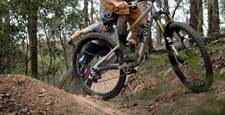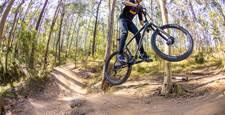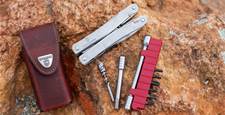Merida's Ninety Six RC XT is a full carbon cross-country race bike with some nifty features.
Photos: Colin Levitch
For nearly fifty years Merida have been shouting something that most brands would rather not talk about: Merida are outly and proudly Asian-made, and in fact were founded by an entrepreneur called Ike Tseng on the principle that bikes made in a factory in Taiwan could be world-class, win races, and generally compete in what, fifty years ago at least, was a market dominated by US and European design and manufacture.
Times sure have changed, and while it’s likely that any bike you buy that isn’t literally handmade is going to come from one of just a few factories in China, Merida are still proud of the quality of their Asian-made bikes. This emphasis on quality has led the brand to take a hybrid East-West approach that’s fairly standard these days, with design and R&D happening just outside Stuttgart in Germany, where a group of large bearded Teutonic men (I’m basing this off the marketing photos), sketch, stroke bits of metal, collaborate in earnest, and then tirelessly whack things until they break.
You may have wondered why most bike brands release new frame models every three or four years, and the Merida business model is a great illustration – when undergoing any R&D, each prototype is cast in the factory in Taiwan, freighted over to Stuttgart, broken by the Germans, who then sketch what they want changed, email that over to head office in Yuanlin Taiwan, and wait for the next prototype to be shipped over. It’s a lengthy process*. Then, when the model is eventually finished, the mould for the frame pieces is expensive to generate, so it takes a good few years to make back the investment, both in dollars and hours. The last change to the Ninety Six was released in May 2015, so there has been some anticipation for this all-new design – and plenty of work and direct feedback from riders has gone into the final product.
*This may not be the actual process
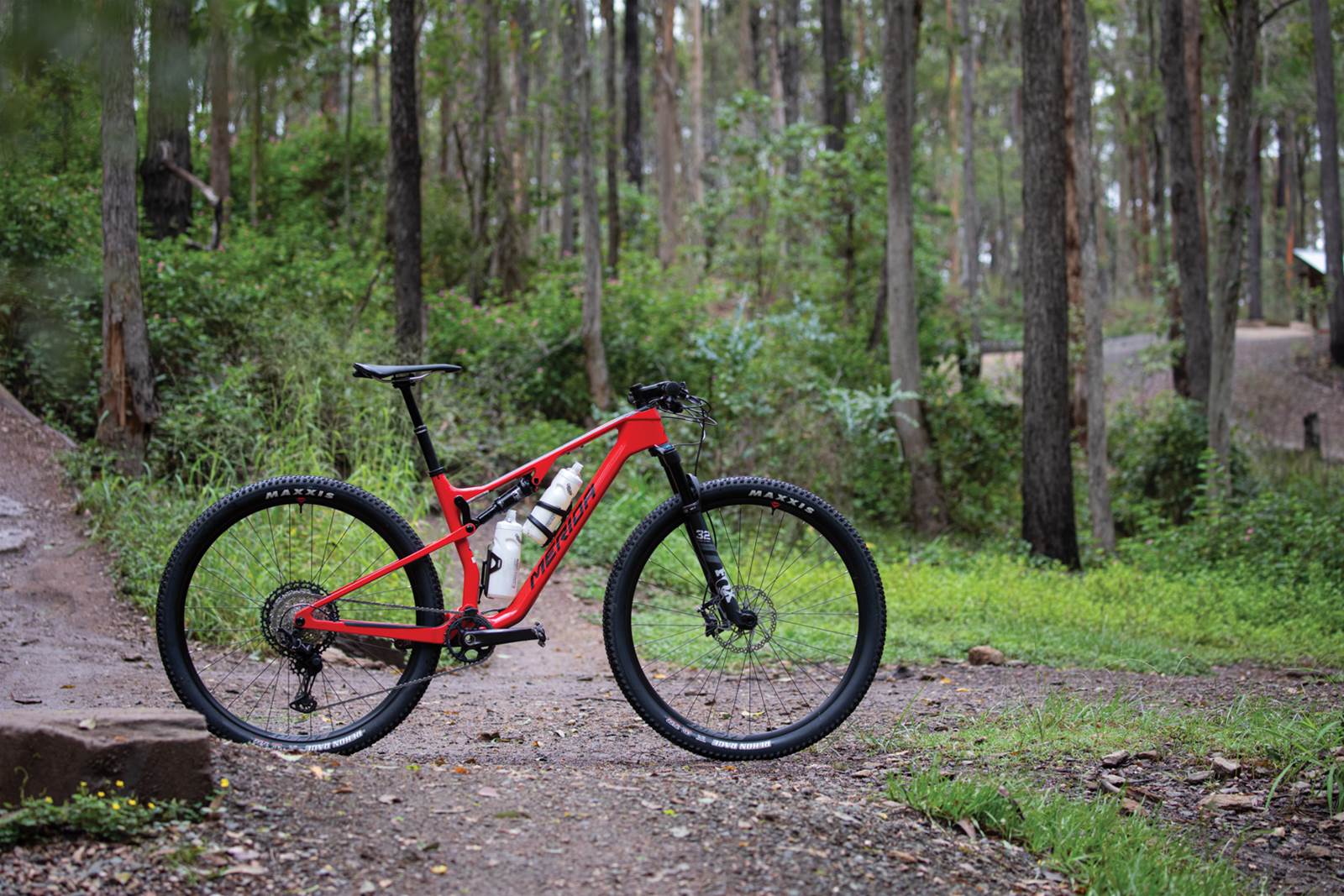
Introducing the Ninety Six RC XT
The Merida Ninety Six RC XT sits third in the brand’s new range of four 2021 XC ‘Ninety Six’ race bikes. The range is intelligently and competitively priced with the top-of-the line RC 9000 juuust a whisker below the $10,000 mark, and with bikes spaced $1,000-$2,000 apart down to the RC 5000 at $5,599. The RC 9000 features Merida’s top CF5 carbon fibre, with the other three bikes in the range, including the RC XT tested here, are fabricated from CF4. The difference is around 150g in frame weight. The next model above the RC XT is the the RC 8000, a pumped up and swole version for the range. For $2,300 more than the RC XT, you get a burlier 120mm fork, meaty tyres, a longer dropper, a 4-piston front brake, a SRAM Eagle/XT spec, and pretty much exactly the same weight as the RC XT – which should give potential buyers plenty to think about. You can easily compare these four on the Merida website if you’re curious, or looking to buy.
The RC XT will suit riders who like to race, but who aren’t trying to qualify for World Championships. The full Shimano Deore XT M8100 drive train and Fox suspension package is a tried and true winner for performance and reliability. We see this as a great option for riders of all ages starting out in racing, racing casually, potentially in age group cross country and marathon events.

Initial Impressions:
The Merida Ninety Six RC XT 2021 frame is full carbon – no alloy swingarms here – furnishing an all-over feeling of quality and stiffness. The threaded bottom bracket shell is a welcome enough feature, easier to service than the pressfit units, and a nod towards longevity for a light weight carbon frame. With a dropped top tube the Ninety Six RC has good standover height, while still allowing two full size water bottles to fit in the main triangle, along with an accessory mount below the top tube.
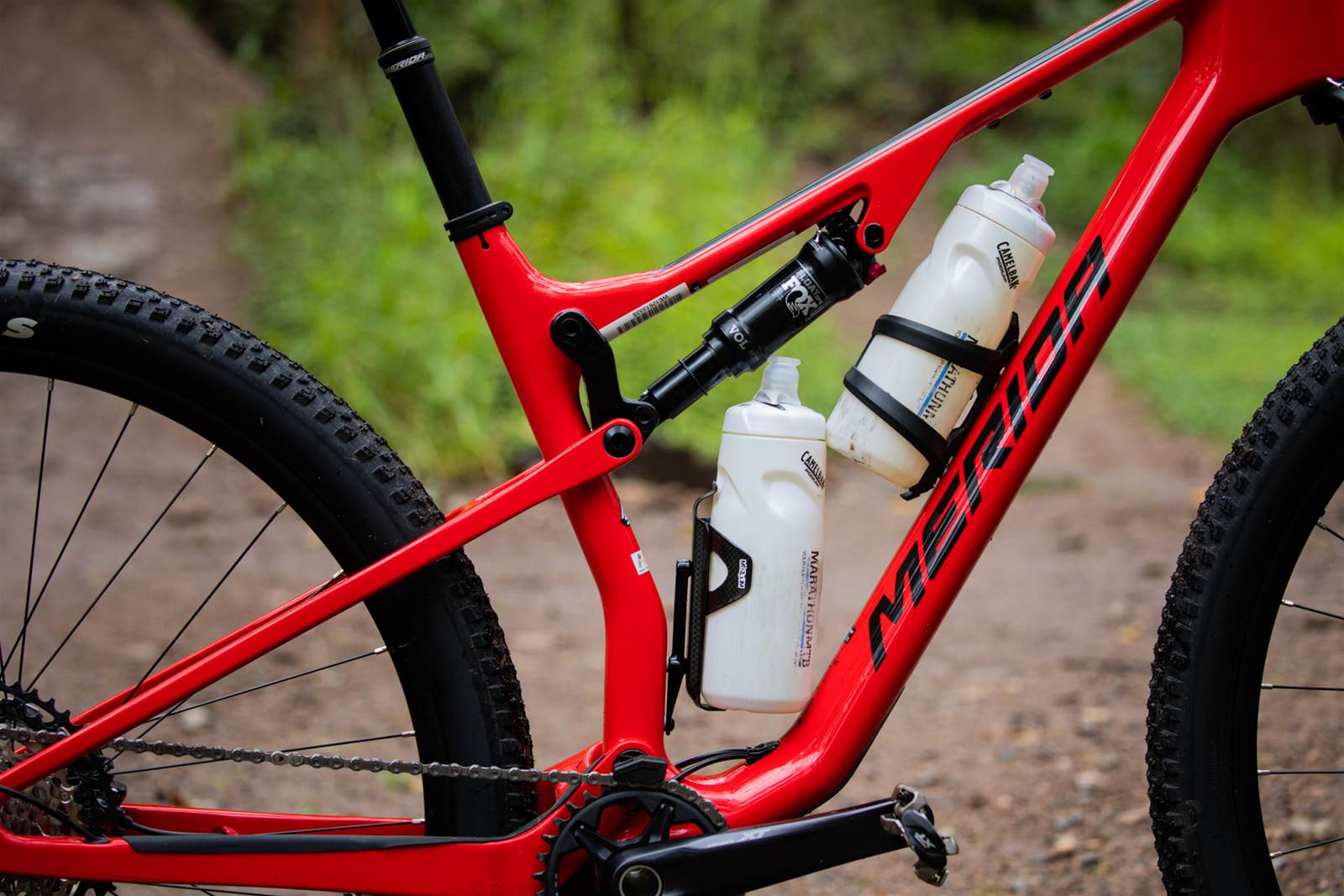
The chain and seat stays have concave contours – i.e. they curve inwards towards the wheel. While this may mean there’s a little more potential for clogging in serious mud (which will cause havoc for every bike anyway), the more weighty benefit is that I never clipped my inner heel on the chain stay – a common point for ugly rub marks and general annoyance (most of us ride slightly duck-toed). The RC XT comes ‘tubeless ready’. What this clever semantic sleight of hand means is that you’ll have to set the rims up tubeless yourself (or your mechanic will) from scratch, including applying tubeless rim tape and buying your own valves. It’s a frustrating process and not something, to my mind, people buying bikes for over $5,000 should be responsible for.
Interested in XC race bikes? Check out some of our other XC bike reviews below:
Orbea Oiz M Team
Trek Supercaliber
Specialized Epic vs Specialized Epic EVO
The Merida Ninety Six RC XT full carbon frame is nicely made with good attention to detail and a couple of interesting features, like an inbuilt chain guide, frame protection on the chain stay and base of the down tube, and new cable outer routing. This revolves around outers entering mostly through the headset top bearing cover and exiting at the base of downtube on the upper side. It's more weatherproof instead of sitting underneath – although the headset cable routing can be a bit fussy at first. While this definitely makes for a neater head tube with no chance of cable rub, out of the box it’s best suited to right to rear (European) brake setup. The six cables and outers that define dual suspension XC bikes with droppers do create an ugly birds nest effect out the front, and wireless can’t come soon enough for those of us who like our race numbers to sit nicely. For now, it’s worth getting a good mechanic to set it up well with precise lengths of outer and hose, so that you can be confident that everything is as tidy as it can be.
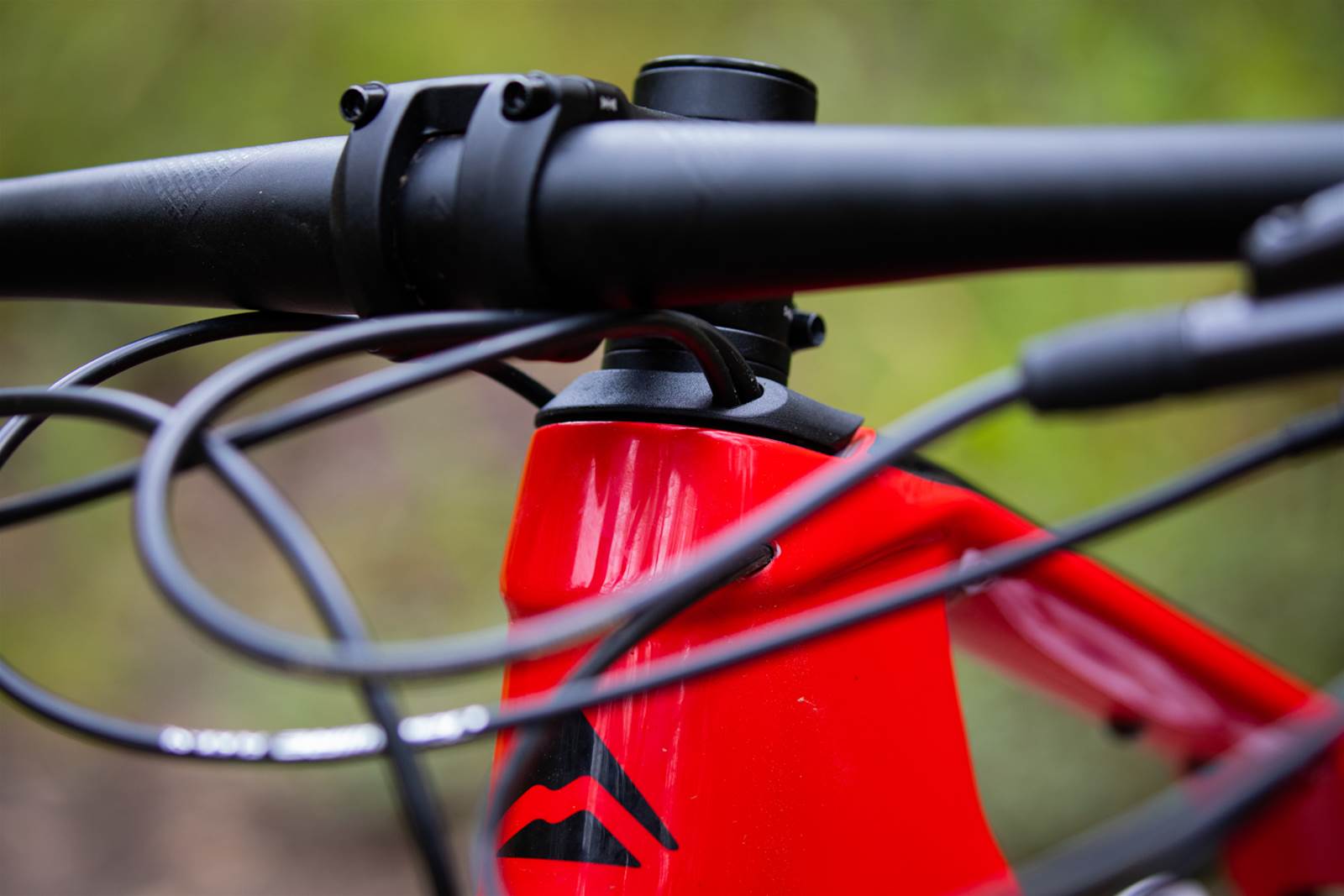
Merida have joined many other manufacturers by ditching the drop out pivot on the Ninety Six. As these tiny pivots only move a tiny amount over their lifetime, they're prone to seizing. With just about every top cross-country bike being fantastic plastic, having a flex stay arrangement saves weight, reduces maintenance, and improves lateral stiffness. It also sees a move to a flat mount rear brake, which has a smaller attachment and is a very neat unit. It allows the part of the frame that needs to flex to get on with the job.
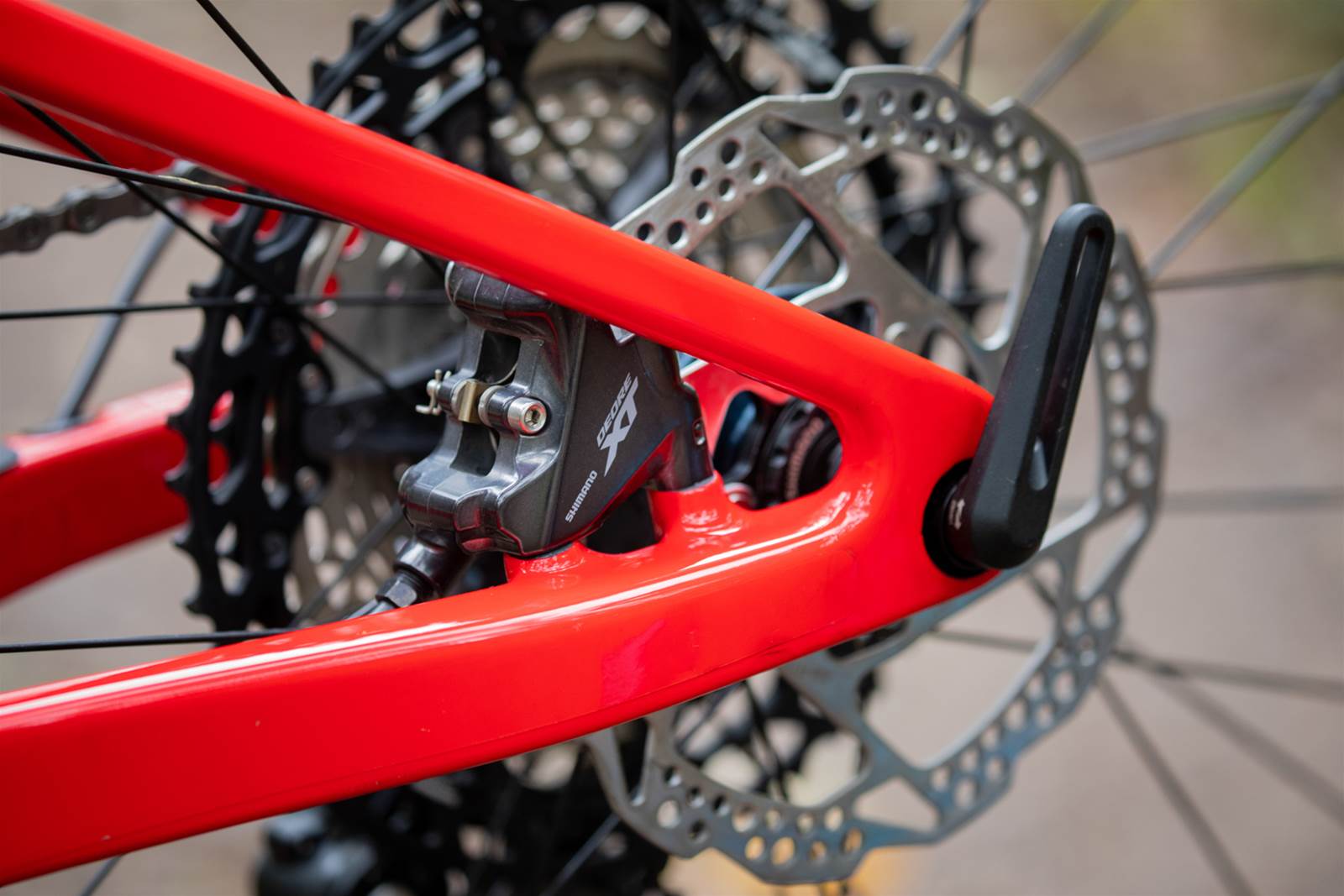
On the rear suspension, Merida have made the leverage curve more progressuve to work better with the small volumes of shocks found on bikes like this. That means it can be nice and supple for stutter bumps, while quite supportive in the midstroke so you don't squish around pedalling over technical terrain – and then it ramps up for bigger impacts.
Merida have really done an overhaul on the geometry of the new Ninety Six – pulling out the reach while steepening the seat angle and making the head angle slacker. On the medium, that equates to a 453mm reach, 76.5 degree seat angle, 68.5 degree head angle and 435mm chain stay. The head tube is a low 95mm and with the low stem the Merida really suits loading up the front of the wheel to keep pushing hard on the trails. The fork has a 44mm offset and the bottom bracket drop is 45mm. What's all that mean? Well you're centred on the bike when climbing, keeping the front wheel grounded and tracking. But on steep descents you can easily get off the back of the seat and the slacker head angle isn't nearly as nervous as previous generation cross-country bikes. The wheel base is 1146mm so it's steadier at speed as well.
Overall, the Merida Ninety Six RC XT is a great looking bike. It’s neat and racy, with attractive lines and a great paint job if you like fire-engine red. The website lists the weight at 11.55kg, and our medium-size weigh-in confirmed this, tipping the scales at a close 11.61kg, just 6g difference and well within a tolerable range for variability.
On The Trail:
The Merida Ninety Six range is designed to service the race market – make no mistake, this is a race bike. Despite its racy pedigree, this is a comfy bike. Out of the box there was little I would change where comfort is concerned. Even the stock Merida Expert CC saddle was totally fine (although it instantly scratched and probably wouldn’t survive long). The stock 740mm flat bars were a comfortable width and felt stiff and racy, and the stock 175mm XT crankset with the 32t chainring and the 10–51t 12-speed cassette are perfect plug and play choices for a race bike suited to the majority of riders’ physiology. These days – changing up or down a chain ring size should be easy to do before you roll out of your Merida dealer if needed.
Tester: Imogen Smith
Riding Experience: Two decades of cross-country and marathon racing.
Generally Rides: Norco Revolver FS 100 and HT
Height: 171cm
Weight: 54kg
Bike Test Track: Ironbark trails, Brisbane Australia
What impressed me most was the stock setup on the Fox Performance 32 Stepcast fork and Fox Float Performance Elite rear shock. Up front, the fork tune was perfectly balanced through the travel, providing plenty of pop for jumping and loading through corners, while serving up pillowy goodness over rough terrain. The In-line Fox shock’s rear tune coupled with the Ninety Six geo provided one of the most stable pedalling platforms I’ve tested for a long time, with the rear swing arm barely moving on smooth, pedally surfaces like uphill fire road. I did spend the time to get the pressure and rebound right, and add a volume spacer to the fork, and these small details really pay off when looking for performance in a 100mm package.
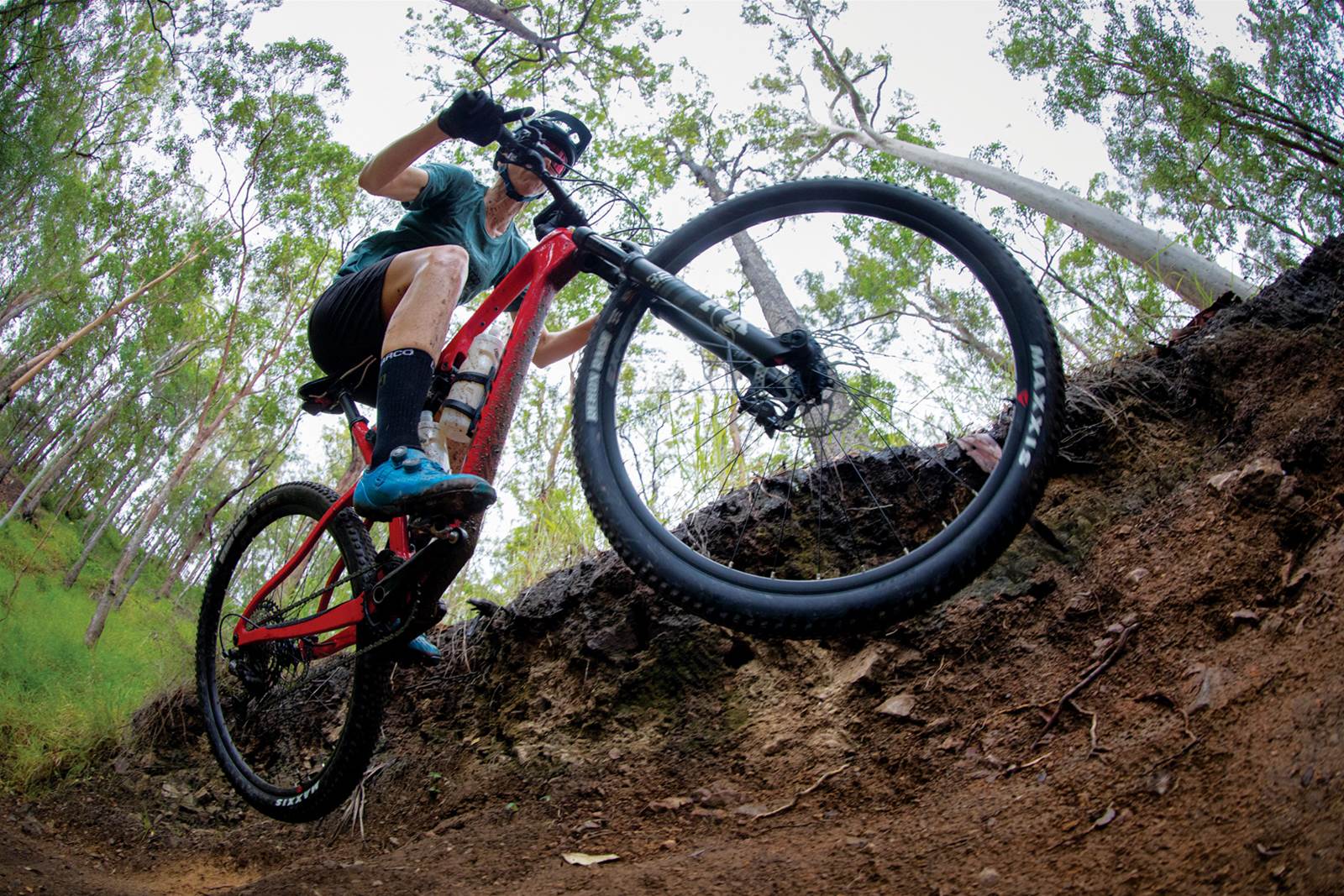
The Ninety Six was very well balanced when tackling fast descents, be they loose and steep, or stacked berms. I really like that Merida have provided a dropper post as stock on this model – it is a great nod to how people actually ride. That really helps keep your weight low, and assists with rapid weight transfers when riding fast.
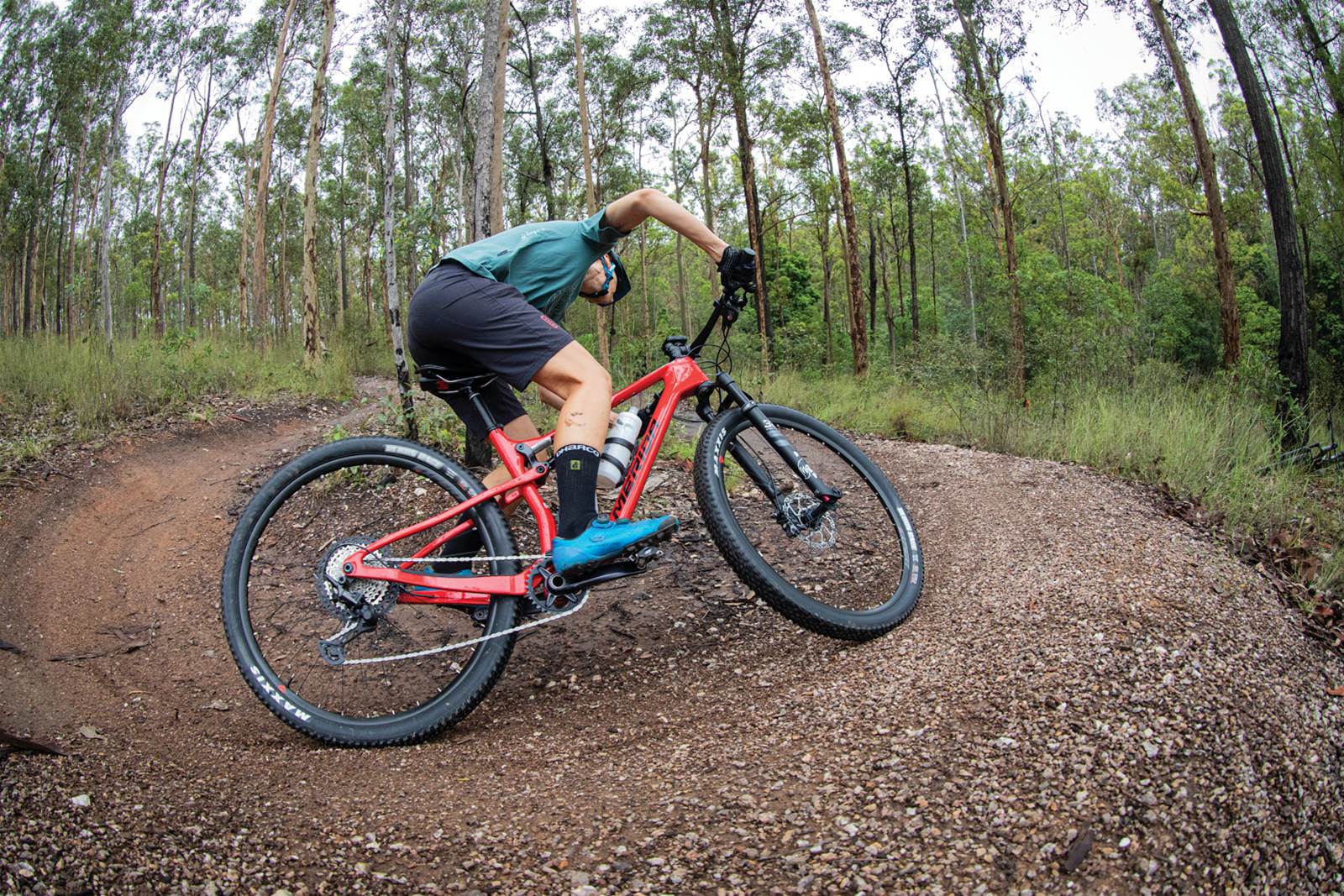
On a race bike, easy function and ergonomics are essential. I found the hybrid RockShox/Shimano lockout/dropper combo pretty finicky to work with. In a nutshell, your dual suspension is actuated by a RockShox TwistLoc – an inward twist to unlock, and released to lock by a thumb button on the inner edge of the grip. The dropper, meanwhile, is also actuated by the left thumb via a lever positioned just below the left-hand grip. It’s all a bit busy, and while I typically get used to new cockpit setups within about 30 minutes, I found that after a few hours’ riding I was till second guessing the controls on the RC XT. Part of the problem was that the TwistLoc requires a pretty big hand movement to activate the suspension, and this movement pulls your hand down, towards you, and away from your brake lever. In a race or fast trail riding scenario you need to be right on the ball to cover your rear brake, unlock your suspension, and actuate the dropper as you transition from climbing or flat to technical sections of trail. This might not be an issue for you, but even if it is, changing lockout systems is about as difficult and expensive as changing tyres.
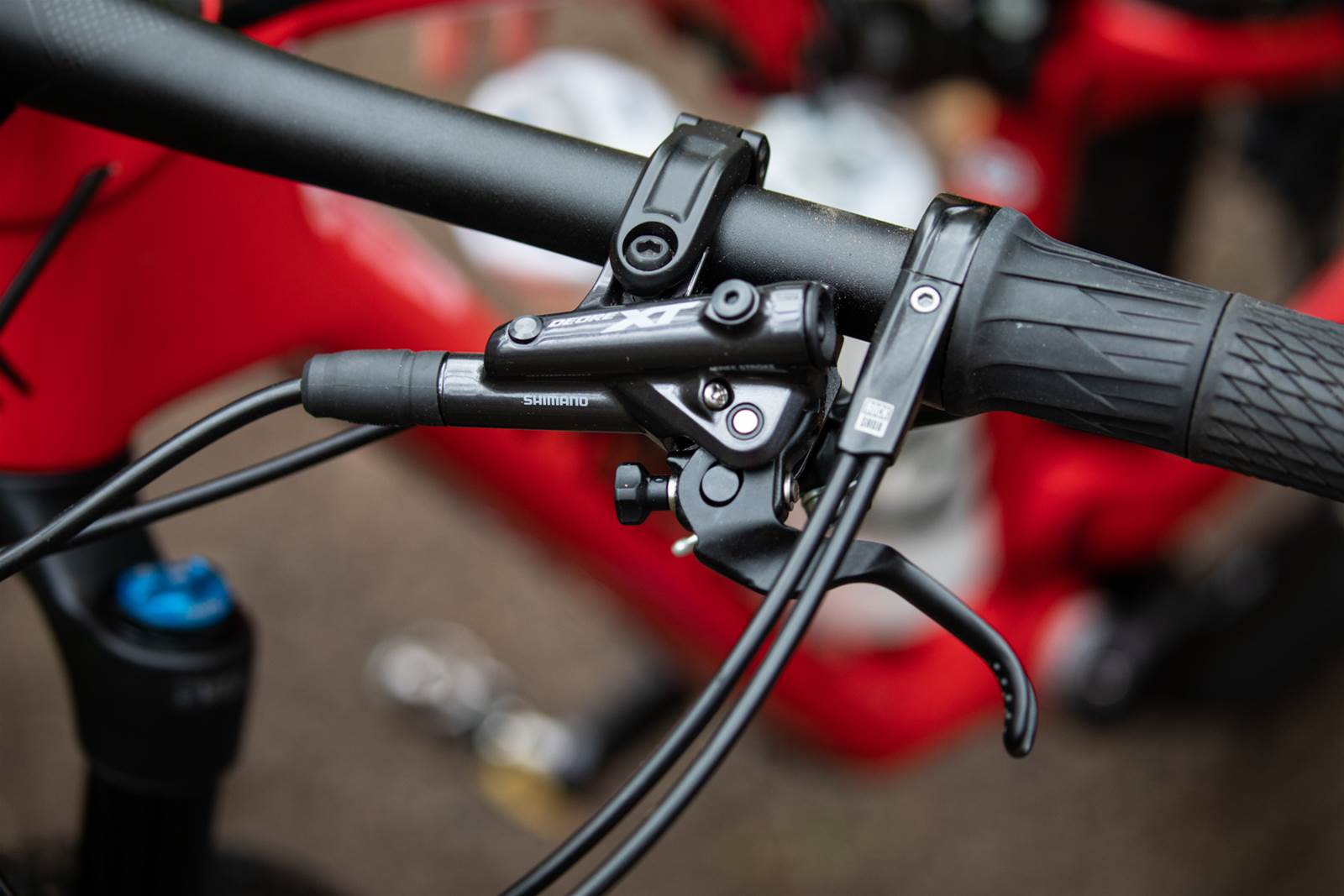
The steeper seat angle and low-set bars combine to make the Ninety Six climb like a rat up a drain pipe. It's quick to accelerate out of the saddle, and well balanced so you don't need to be straining over the bars on the nose of the saddle. I liked the stiffness through the front end, and no doubt the large head tube and down tube play an important role here.
If there is one upgrade I could suggest for this bike, a lighter, wider-rimmed wheel set is top of the list. I found a marked difference between the 25mm and 30mm inner width rims I’m used to running and the setup tested here. It takes more pressure to dig the front wheel in, especially when loading up in the final compression phase of tight corners, and the difference is more pronounced the flatter the corner is. The Maxxis Rekon Race 2.25” tyres are good choices to start out with, but I’d suggest running wider tyres if at all possible, and I think that while you’d cop a tiny bit more rolling resistance, a Maxxis Rekon on the front would expand the performance window of the bike.
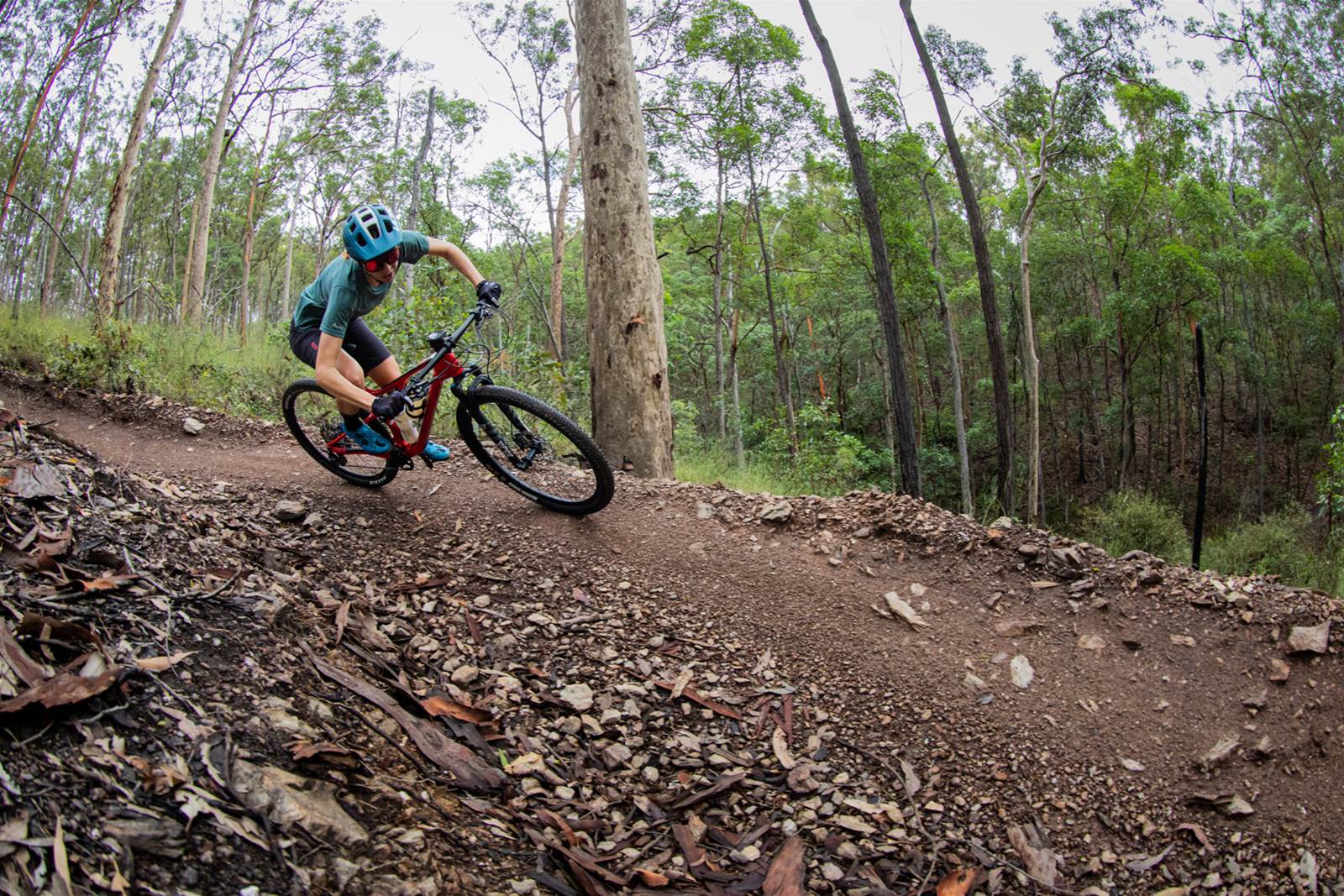
The Shimano XT brakes and group set almost didn’t get a mention in this review – that’s because they perform so well that it’s easy not to notice them – which is exactly what you want from important components. Shimano's Deore XT M8100 brakes are a reliable 2-piston arrangement with the new lever design and iSpec EV mount so you can adjust where the shifter (and dropper lever) sit. This is a Servowave lever with easily adjustable lever reach, and exceptional lever feel and modulation. Shimano updated the master cylinder for more modulation on this series, and it means these brakes are very hard to beat for feel and reliability. The rotors aren't XT spec and their 180/160mm sizing suits aggressive cross-country riding. If you need more oomph, maybe look at some IceTech XT models.
Our Take:
The Merida Ninety Six RC XT might suit riders looking for a fast-climbing and capable light and very fast trail bike, but it really comes into its own as a mid-level race bike for those interested in zip-tying on a number plate, but not really considering joining the World Cup circuit. It’s well constructed around a full-carbon frame, with a lot of thought given to cable routing, features and finish. The Fox suspension performed flawlessly and the XT spec is light and reliable. Small details like the integrated tool into the seat and rear axle, and of course dual bottle carrying ability all add up to make for a bike that's a great companion between the tape on long or short events. For any rider looking to ride long hours or race as such, you can't look past the fact that you can have a multitool permanently attached, along with two bottle cages inside the main triangle AND there's still an accessory mount for a pump or inflator. This keeps your pockets free for food on race day, and it's a luxury that not everyone on a cross-country full-suspension bike has.
From: Advance Traders
Price: $6399
Related Articles
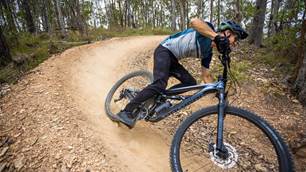
TESTED: 2024 Polygon Siskiu T6 trail bike
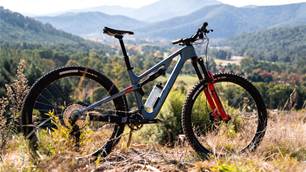
TESTED: Merida One-Forty 6000
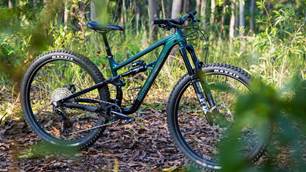












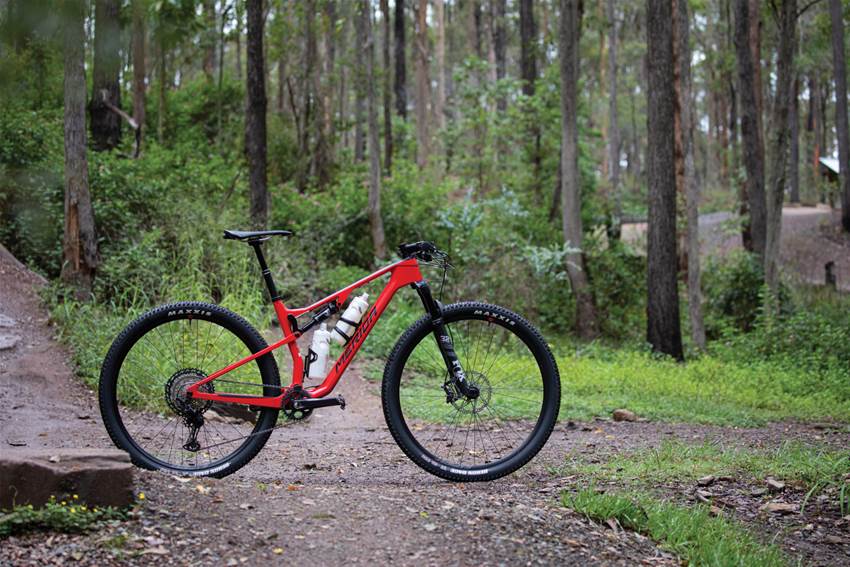
.jpeg&h=115&w=225&c=1&s=1)

.jpeg&h=115&w=225&c=1&s=1)

